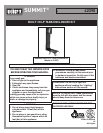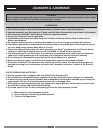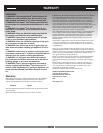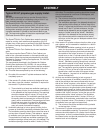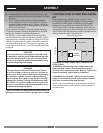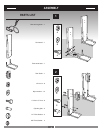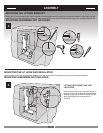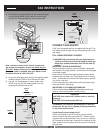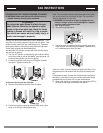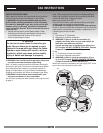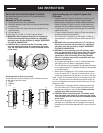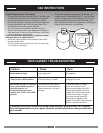Special offers from our partners!

Find Replacement BBQ Parts for 20,308 Models. Repair your BBQ today.

4
Typical 20 LP propane gas supply Instal-
lation
We strongly recommend that you use the Summit
®
Built-In
Tank Cabinet (#21280) for installations using a 20 lb LP cyl-
inder, mounted remotely in an “island” structure.
The Summit
®
Built-In Tank Cabinet is a CSA listed acces-
sory for installing a remote mounted 20 lb LP cylinder, in an
“island” structure. Summit
®
Built-In Tank Cabinet has a hose
and regulator assembly and gas connections, for connecting
a remote mounted LP cylinder to the Summit
®
Built-In gas
grill. The hose and regulator is listed as a required part of the
CSA listed Summit
®
Built-In gas grill.
The Summit
®
Built-In Tank Cabinet also meets the require-
ments for venting, tank retention and separation of the LP
cylinder from a heat source as outlined in the ANSI Standard
for Outdoor Cooking Gas Appliances, Z21.58/CSA 1.6 for LP
enclosures.
The Summit
®
Built-In Tank Cabinet has its own installation
guide.
If you do not use the Summit
®
Built-In Tank Cabinet, you
need to hire a licensed contractor or licensed plumber and
they need to follow the requirements described in the ANSI
Standard for Outdoor Cooking Gas Appliances, Z21.58/CSA
1.6 for LP enclosures.
The requirements described in the Standard for Outdoor
Cooking Gas Appliances, Z21.58/CSA 1.6. are as follows;
A remote enclosure for an LP gas cylinder shall be ventilated
by openings at both the upper and lower levels of the cylin-
der. This shall be accomplished by one of the following:
a). One side of the remote LP cylinder enclosure shall be
completely open; or
b). If the remote LP cylinder enclosure is designed to have
four sides, a top and a bottom, ventilation is required for
the remote LP cylinder enclosure;
1). There should be at least two ventilation openings, (a
hole or group of holes, for the purpose of ventilation)
in the sidewalls of the island structure. The openings
should be located within 5 inches (127mm) of the
top of the enclosure. The ventilation openings should
be equally sized and spaced at a minimum of 90 de-
grees, and be unobstructed. The openings shall have
a total free open area of not less than 20 square
inches. (This relates to1 square inch of ventilation
area, per pound of stored fuel capacity).
2). Ventilation openings (a hole or group of holes, for the
purpose of ventilation) should be provided at fl oor level.
The ventilation openings should have a total free area of
not less than 10 square inches. (This relates to square
of ventilation area, per pound of stored fuel capacity).
There should be at least two ventilation openings if the
ventilation openings at fl oor level are in the sidewall. The
ventilation openings should be within 5 inches (127mm)
of the fl oor. The ventilation openings should be of equal
size and be spaced at a minimum of 90 degrees, and
should be unobstructed.
3). The minimum size of the ventilation hole (s) should
not be less than 1/4 inch.
4). The ventilation openings in the sidewalls should not
allow venting into the empty or “hollow” area of the
“island”. If a gas leak should occur or the LP cylinder
should vent in the LP cylinder enclosure, the gas
should not be allowed to vent or migrate into the
empty or “hollow” area of the “island”. Ventilation
openings in the sidewalls of the enclosure should
only communicate with the outside of the “island”
structure, so that the gas can dissipate outside of the
“island” structure.
c). If the remote LP cylinder enclosure has four sides, a top
and a bottom, and is intended for installation in a built-in
“island” enclosure;
1). At least one ventilation opening (a hole or group of
holes, for the purpose of ventilation) needs to be on
one side of the enclosure that communicates with
the outside of the “island” structure. If a gas leak
should occur or the LP cylinder should vent in the LP
cylinder enclosure, the gas should not be allowed to
vent or migrate into the empty or “hollow” area of the
“island”. Ventilation openings should only communi-
cate with the outside of the “island” structure, so that
the gas can dissipate outside of the “island” struc-
ture. The ventilation opening should be located within
5 inches (127mm) of the top of the enclosure, and
should have a total free area of 20 square inches.
(This relates to 1 square inch of ventilation area, per
pound of stored fuel).
2). At least one ventilation opening (a hole or group of
holes, for the purpose of ventilation) needs to be on one
side of the enclosure that communicates with the out-
side of the “island” structure, at the bottom. If a gas leak
should occur or the LP cylinder should vent in the LP
cylinder enclosure, the gas should not be allowed to vent
or migrate into the empty or “hollow” area of the “island”.
Ventilation openings should only communicate with the
outside of the “island” structure, so that the gas can dis-
sipate outside of the “island” structure. The ventilation
opening should be located within 5 inches (127mm) of
the bottom of the enclosure, and should have a total free
area of 10 square inches. (This relates to 1/4 square inch
of ventilation area, per pound of stored fuel).
3). The minimum size of the ventilation hole (s) should
not be less than 1/4 inch.
d). The remote LP cylinder enclosure should be constructed
with non-combustible materials. The remote LP cylinder
enclosure should isolate the LP cylinder from the burner
compartment, so that it provides shielding from radiation,
be a fl ame barrier and provide protection from foreign
material such as hot drippings.
ASSEMBLY



